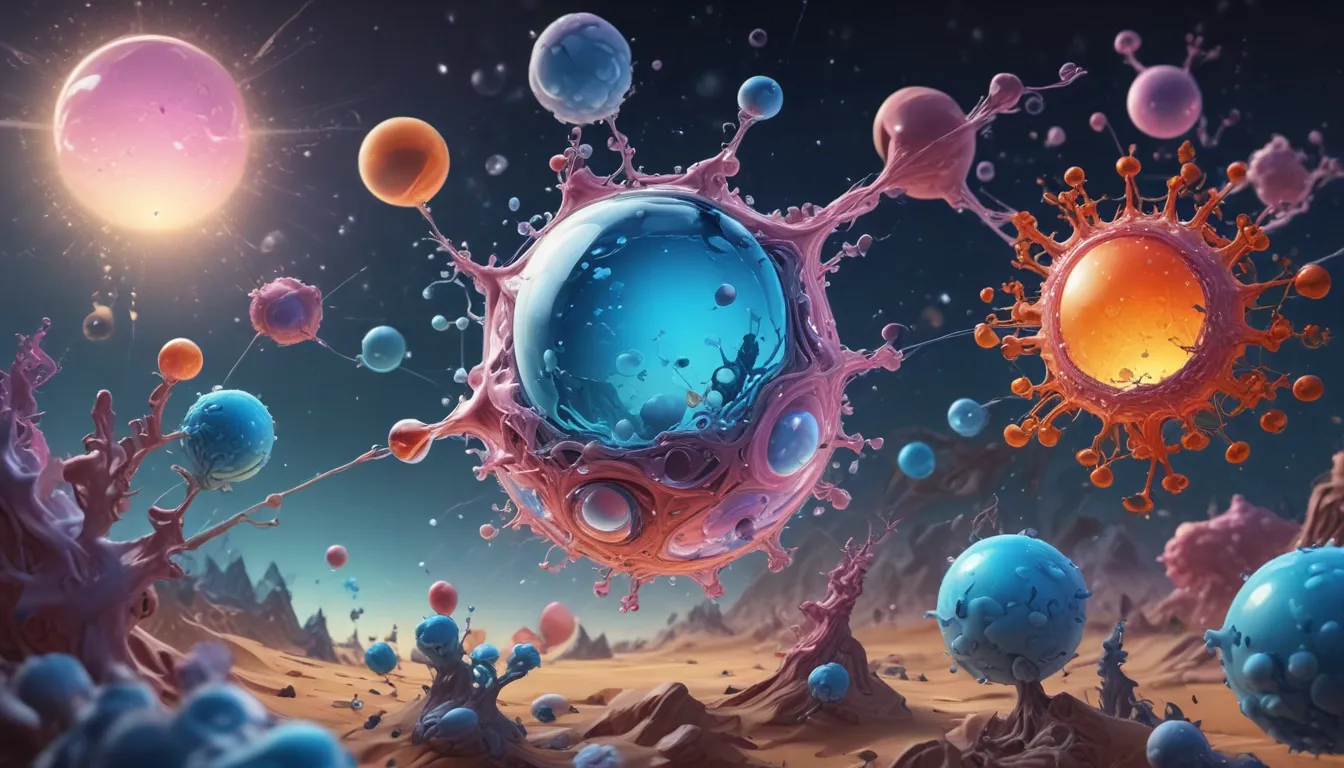A Note About Images: The images used in our articles are for illustration purposes only and may not exactly match the content. They are meant to engage readers, but the text should be relied upon for accurate information.
Are you ready to embark on a captivating journey through the realm of supramolecular chemistry? This fascinating field delves into the interactions between molecules, unraveling the mysteries of how tiny entities can come together to form intricate structures with unique properties and functions. Beyond the confines of traditional chemistry, supramolecular chemistry harnesses the power of non-covalent interactions to create molecular assemblies that hold immense potential in diverse industries such as materials science, drug delivery, and nanotechnology.
Exploring the Intriguing World of Supramolecular Chemistry
Supramolecular chemistry serves as a beacon of innovation, shedding light on the complex interplay between molecules and the remarkable structures they can create. By focusing on non-covalent interactions like hydrogen bonding, electrostatic forces, and van der Waals interactions, scientists can unravel the secrets behind molecular self-assembly and the birth of advanced materials with unprecedented capabilities.
Unbelievable Facts Unveiled
Let’s dive deep into the spellbinding realm of supramolecular chemistry and uncover 16 mind-boggling facts that showcase the endless possibilities and real-world applications of this captivating discipline. From the inception of supramolecular structures to the emergence of supramolecular machines, each fact will leave you awestruck by the wonders that supramolecular chemistry has to offer.
Key Takeaways
- Supramolecular chemistry unveils the intricate world of molecular interactions, paving the way for revolutionary materials and potential breakthroughs in healthcare.
- Through the magic of non-covalent interactions, supramolecular chemistry propels the creation of miniature machines, intelligent materials, and even synthetic systems for renewable energy sources.
Delving into the Core of Supramolecular Chemistry
At the heart of supramolecular chemistry lies the exploration of molecular interactions, transcending the boundaries of conventional chemical studies. By delving into the nuances of non-covalent bonding, researchers can unravel the potential of developing new materials and innovative solutions across diverse domains, including drug delivery, nanotechnology, and catalysis.
Unveiling the Marvels of Self-Assembling Structures
One of the most enchanting aspects of supramolecular chemistry is its ability to orchestrate the creation of self-assembling structures. Through meticulous molecular design, molecules can spontaneously arrange themselves into larger entities such as micelles, vesicles, and supramolecular polymers. This elegant dance of molecular forces holds the key to unlocking materials with extraordinary properties and functionalities.
Revolutionizing Drug Delivery with Supramolecular Chemistry
The realm of supramolecular chemistry stands at the forefront of revolutionizing targeted drug delivery systems. By engineering supramolecular structures with precision binding sites, scientists can craft drug carriers that release therapeutic agents exclusively at the intended destination, enhancing treatment efficacy while minimizing side effects. This groundbreaking approach heralds a new era of personalized and precise medicine.
Pioneering the Era of Molecular Machines
Supramolecular chemistry has ushered in a new era of molecular machines, intricate devices composed of individual molecules capable of performing mechanical tasks. These miniature marvels mirror the functionalities of macroscopic machines, offering unparalleled potential in nanotechnology, sensing, and drug delivery. As researchers delve deeper, the horizons of molecular machines continue to expand, promising revolutionary applications across various domains.
Crafting Stimuli-Responsive Materials through Supramolecular Chemistry
The art of supramolecular chemistry empowers scientists to design materials that respond dynamically to external stimuli like light, heat, or pH variations. By imbuing materials with specific molecular interactions, researchers can trigger reversible changes in properties or initiate self-healing processes. These stimuli-responsive materials hold boundless potential to reshape industries such as electronics, sensor technology, and smart coatings.
Elevating Sensor Development with Supramolecular Chemistry
Supramolecular chemistry serves as a cornerstone in the realm of sensor development, enabling the creation of highly sensitive and selective detection systems. By tailoring molecules with precise binding sites for target molecules, researchers can craft sensors with unparalleled accuracy across applications ranging from environmental monitoring to medical diagnostics and food safety assurance.
Unraveling the Intricacies of Biological Systems
The profound insights offered by supramolecular chemistry shed light on the intricate tapestry of interactions within biological systems. From protein folding to enzyme catalysis and signal transduction, the subtle dance of non-covalent interactions underpins vital biological processes. Unraveling these molecular intricacies holds the key to pioneering new therapeutic interventions and drug discovery pathways.
Revolutionizing Energy Storage with Supramolecular Chemistry
Supramolecular chemistry stands as a pivotal force in the design of advanced materials for energy storage applications. By harnessing the power of non-covalent interactions, scientists have unlocked materials boasting high energy storage capacities, enhanced charge transport properties, and superior stability. These groundbreaking advancements propel the development of efficient batteries, supercapacitors, and fuel cells, ushering in a new era of sustainable energy solutions.
Mastering Crystal Structures through Supramolecular Chemistry
The art of supramolecular chemistry grants researchers precise control over crystal structures by manipulating molecular interactions. Through the modulation of non-covalent bonding between molecules, scientists can dictate the formation of tailored crystal structures with desired properties. This ability to engineer crystal structures heralds transformative implications across pharmaceuticals, materials science, and crystallography.
Illuminating the Path to Novel Catalyst Design
Supramolecular chemistry serves as a beacon of innovation in catalyst design, offering fresh perspectives on creating catalysts with enhanced selectivity and activity. By harnessing non-covalent interactions, researchers can engineer catalysts that catalyze reactions with precision, reducing energy consumption and minimizing the use of hazardous reagents. This heralds a new chapter in sustainable chemical processes.
Pioneering Artificial Enzymes through Supramolecular Chemistry
The realm of supramolecular chemistry has birthed artificial enzymes that mirror the functionalities of natural enzymes. These synthetic marvels exhibit catalytic activity and selectivity, unlocking a realm of applications spanning drug synthesis, biotechnology, and environmental remediation. The dawn of artificial enzymes heralds a paradigm shift in molecular catalysis and biocatalytic processes.
Redefining Sensing Technologies with Molecular Sensors
Supramolecular chemistry has redefined sensing technologies through the creation of molecular sensors that detect specific molecules or ions. Leveraging molecular recognition events and signal transduction mechanisms, these sensors offer unmatched accuracy and sensitivity across domains like environmental monitoring, medical diagnostics, and forensic analysis. The era of molecular sensors promises a new frontier in precision detection and analysis.
Shaping the Future of Molecular Electronics
Supramolecular chemistry converges with the realm of molecular electronics, where individual molecules serve as functional components in electronic devices. Through precise manipulation of molecules and control over their electronic properties via non-covalent interactions, scientists are forging a path to devices with enhanced performance and novel functionalities. The frontier of molecular electronics promises to redefine the landscape of electronic technologies.
Harnessing Sustainable Energy through Artificial Photosystems
Supramolecular chemistry has unlocked the door to artificial photosystems mirroring natural photosynthesis processes. These systems harness light energy to drive chemical reactions like water splitting and carbon dioxide reduction, paving the way for clean and renewable fuel production. Artificial photosystems reignite hopes for sustainable energy generation and storage, offering a beacon of promise in the quest for eco-friendly solutions.
Embracing Dynamic Materials through Supramolecular Chemistry
The realm of supramolecular chemistry heralds the dawn of dynamic materials capable of undergoing reversible changes in response to external stimuli. Whether in drug delivery, sensing applications, or adaptive materials, these dynamic materials offer unparalleled versatility in adapting to changing environments. The era of dynamic materials ushers in a new age of innovation, holding the promise of shaping industries with their transformative capabilities.
Inspiring Future Research and Innovation
Supramolecular chemistry stands as a testament to boundless possibilities, inspiring researchers worldwide to push the boundaries of scientific inquiry. From creating new materials to deciphering the complexities of biological systems, supramolecular chemistry stands poised to address global challenges and fuel innovation across scientific disciplines.
Unveiling the Endless Wonders of Supramolecular Chemistry
In a world brimming with wonders, supramolecular chemistry stands as a beacon of fascination and innovation. From the enchanting realm of molecular assemblies to the realm of self-healing materials, this branch of chemistry illuminates the path to understanding molecular interactions and their transformative applications. Step by step, we unlock the potential of harnessing weak forces to craft complex structures, unveiling a universe of possibilities in domains ranging from healthcare and drug delivery to materials science and nanotechnology.
Frequently Asked Questions
Q: What is Supramolecular Chemistry?
A: Supramolecular Chemistry is a branch of chemistry exploring weak molecular interactions and the formation of intricate structures beyond individual molecules.
Q: What are some applications of Supramolecular Chemistry?
A: Supramolecular Chemistry finds applications in drug delivery, materials science, catalysis, sensors, and nanotechnology.
Q: What are the key principles of Supramolecular Chemistry?
A: The key principles of Supramolecular Chemistry involve leveraging non-covalent interactions like hydrogen bonding, hydrophobic interactions, electrostatic interactions, and π-stacking to assemble molecular units into larger and more complex structures.
Q: What are some examples of supramolecular structures?
A: Examples include molecular self-assembly, coordination complexes, host-guest interactions, and supramolecular polymers.
Q: How does Supramolecular Chemistry contribute to nanotechnology?
A: Supramolecular Chemistry plays a vital role in nanotechnology by facilitating the design and synthesis of functional nanomaterials and nanodevices.
Q: Can Supramolecular Chemistry be applied in drug delivery?
A: Absolutely! Supramolecular Chemistry offers innovative strategies for targeted drug delivery, enhancing drug solubility, and stability.
Join us as we unravel the mysteries of supramolecular chemistry, exploring the captivating realm of host-guest interactions that give rise to extraordinary properties and functions through unique molecular partnerships. Stay tuned for more awe-inspiring insights and mind-bending facts as we delve deeper into this extraordinary branch of chemistry!






